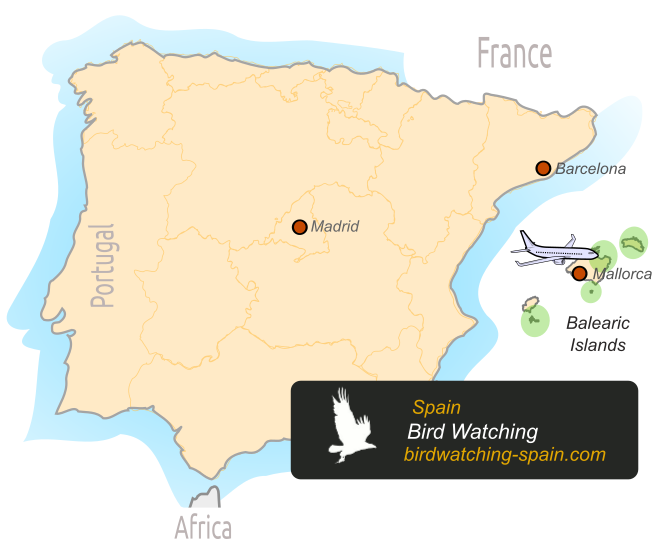Birding in Balearic Islands
The four main islands are Ibiza, Mallorca, Minorca, and Formentara, and each present a unique opportunity for birdwatchers to see native birds as well as migratory species passing from North Africa.
The Balearic Islands region in Spain is an archipelago in the Western Mediterranean, a collection of small islands rich with wildlife.

Birders can see over 300 species of birds in this region.

Parc Natural de S’Albufera on Mallorca. Photo by Scouse_and_Jules
Natural parks
There are multiple nature preserves on the Islands, the largest being the Parc Natural de S’Albufera on Mallorca. This park is a large wetland area with a series of lagoons and natural canals.
The endemic Balearic shearwater lives in the marshes here, which is an increasingly rare threatened species of seabird due to development for tourism on the island.

Photo by marcoarnunes
Other marsh birds thrive here, including the bright purple swamphen or purple gallinule, the squacco heron, the purple heron, the night heron, and the little bittern.
Another park in the South of Mallorca, the Salinas de Migjorn, is a salt marsh landscape that attracts many different raptors, including ospreys, kestrels, and marsh harriers.
The Ses Salines nature park includes both the southern part of Ibiza and the north of the island of Formentara.
This preserve has beaches, sand dunes, and salt flats, attracting a great number of flamingos and herons in their colonies during the spring and summer.
Other seabirds like the Audouin’s gull and the black-winged stilt flock here as well.
Migratory birds
The Balearic Islands lie directly in the path of many migratory birds passing from Northern Africa to farther north in Europe.
Eleanor’s falcons breed on the islands after flying up from Madagascar, as part of their over 9,000km (5,600 mile) migration route –birders can watch these birds of prey flock in large groups to hunt and mate.

Eleonora’s Falcon at Cap Formentor on Mallorca. Photo by Jürgen Dietrich
Different species of colorful bee-eaters also pass through from Africa.
Inland species
In the brush areas of the islands, just beyond the coasts, birders can find the dramatic crested hoopoe, as well as the endemic Balearic warbler with its rattling song.
The common crossbill, the tiny woodchat shrike, and the even smaller blue tit also live inland.
Birdwatchers who climb higher up to cragged peaks on the islands will find the Cinereous vulture or black vulture, one of the largest birds of prey in the world.
In the evening, careful birders may spot the tiny scops owl camouflaged against a tree.
Wryneck woodpeckers live in the trees on the Balearic Islands as well.
Traveling in the Balearic Islands
Travelers will find no shortage of places to stay or beaches to rest on throughout the Balearic Islands region.
Ibiza is famous for its nightlife and parties during the summer, and its legendary port is a UNESCO World Heritage site.
Formentara is more sparsely populated and can only be accessed by boat from Ibiza. Formentara’s rustic nature means it has long beaches of unspoiled coastline, and there are many hiking and biking trails between small villages.
Minorca is famous for its summer festivals.
Mallorca holds the capital city of Palma, many hotels and tourist amenities, and plenty of places to stay near the natural parks.
Each island has its own character, and each will bring pleasure to travelers and birdwatchers alike.
